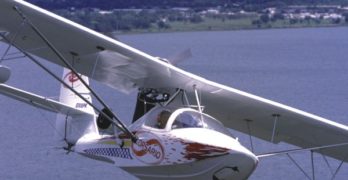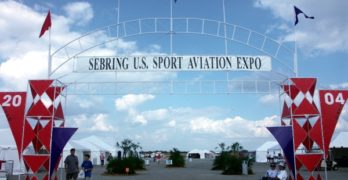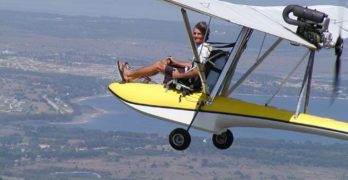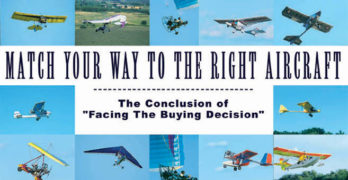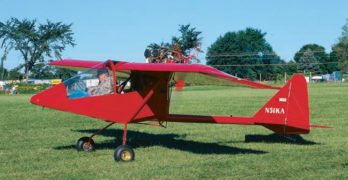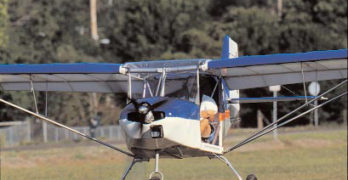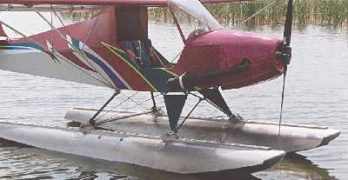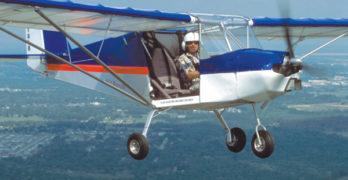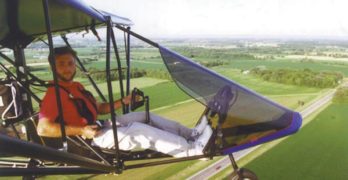Brazilian Amphibious Beauty
Most Americans
are unaware of the Corsario. Importer Steven Cohen is out to change that. He and his partner, Phil Klein, are marketing this handsome amphibian, which they import from Brazil. Not a brand-new design, this is the MK5 model – it’s been through four previous iterations.
The Corsario comes from a South American company called Microleve founded in 1982, back near the beginning of the ultralight era. The company proudly states, “Aside from being the first ultralight manufacturer in Brazil, the quality of our products has made Microleve the biggest seller of ultralight aircraft in Latin America.”
In 23 years of operation, Microleve claims to have delivered more than 1,400 ultralight aircraft, including almost 20 different models, named as MX1, MX2, ML200, ML300, ML300M, ML300MF, ML400, ML400T, ML450, ML500T, CORSARIO MK1, MK2, MK3, MK4, and MK5. As you might surmise by reviewing this list, the Brazilian company has taken several of their models through a series of refinements and the Corsario is no exception.
Search Results for : aventura
Not finding exactly what you expected? Try our advanced search option.
Select a manufacturer to go straight to all our content about that manufacturer.
Select an aircraft model to go straight to all our content about that model.
Sebring 2004: First Impressions
The U.S. Sport Aviation Expo in October 2004 was the first event to focus exclusively on Light-Sport Aircraft.
ou never get a second chance to make a first impression. With that in mind, you might ask how visitors regarded the first U.S. Sport Aviation Expo, held in Sebring, Florida, from October 28-31, 2004. The Expo was the first of its kind aiming at the new Sport Pilot/Light-Sport Aircraft (LSA) segment, and it was a focused event, featuring only LSAs and ultralights. Is that two strikes against it or two good reasons for it to succeed?
From what I could see, those who attended the Sebring event were satisfied. Set aside for the moment reports elsewhere that the show was sparsely attended. It was the first of its kind. And as word of mouth is accepted to be the best marketing tool for shows, the attendance figures should present no surprise. The vendors were satisfied, and visitors also seemed to feel good about the selection of aircraft, the availability and ease of demo flights and the wide array of educational forums.
Connie Amphib — “The Flying Float” (and it is!)
Check out Bobbie Bailey’s Connie Amphib.
Many pilots are aware of aircraft referred to as flying boats. Among ultralight aircraft, the Aventura, SeaRey and Buccaneer stand out as good examples as do trikes like Polaris’ Flying Inflatable Boat. The flying boat reference describes those aircraft built around a boat hull with substantially different structure than airplanes equipped with two floats.
That clear definition is blurred by the introduction of a novel new ultralight from the inventive mind of Bobbie Bailey. His new Connie amphibian is neither flying boat nor a float-equipped ultralight. My BRS associate, Gregg Ellsworth, tagged it a “flying float.” Works for me.
Canada’s Lotus Float company offers a single float setup that functions much the same way but is an add-on to a wheeled ultralight. This may make a perfectly fine floatplane, but you have to do the fitting yourself, and it simply won’t be as elegant as Bailey’s Connie amphib.
How-to-Buy a Lightplane — Part 3 of 3
In the previous two installments, we’ve discussed you, the pilot, and the many types of aircraft choices you have. As we wrap up this series, we’ll put it all together and try to help you narrow your choices to a few models.
Notice the word “try.” It is important that you understand that it is not possible to direct you to the one-and-only best choice of aircraft. Novice buyers often seek assistance but even experienced pilots can become swayed and end up purchasing the wrong aircraft for their needs and desires. Because aircraft purchases are commonly emotional decisions, it is helpful to gain a “second opinion” to help make a more rational choice.
Many years ago, at the beginning of my career writing articles in light aviation, I made a similar attempt to help hang glider pilots choose the right glider. I compared nine contemporary models to an idealized “perfect” glider and through a series of questions much like those below, tried to steer pilots to the one right glider for them.
How-to-Buy a Lightplane — Part 2 of 3
FACING THE BUYING DECISION, PART II
Last time we discussed the pilot (you!); this time we discuss the many types of aircraft choices you have. In the last installment, we’ll put these together and help you narrow your choices to a few models.
What Kind of Pilot Are You?
Let’s just say you actually know yourself. While this sounds like a comment that deserves a “Duh!” response, don’t be too quick to judge. If every pilot or buyer of aircraft knew what they needed or wanted, my job would be easier. But it isn’t so. Most pilots know something about what they want, but many don’t have enough information to make the best decision.
Some readers are “experts.” A good many ultralight or light plane enthusiasts have been around long enough and owned enough variety of ultralights to know what they like.
These veteran sport aviators represent a lot of combined experience.
Light Sport Aircraft – Sidebar 2
Light Sport Aircraft Manufacturer List*
American Fixed-Wing Manufacturers
Brand
Sample Models
Telephone
E-Mail
Website (www. assumed)
Ace Aircraft
Corben Baby Ace/Jr. Ace
706-886-6341
aceair@alltel.net
exp-aircraft.com/aircraft/ace/ace.html
Aerocomp
Merlin
321-453-6641
info@aerocompinc.com
aerocompinc.com
Arnet Pereyra
Aventura I and II
321-635-8005
info@sea-plane.com
sea-plane.com
Avid Aircraft
Mark IV Bandit
406-682-5615
sales@avidair.com
avidair.com
Capella Aircraft
Capella SS Fastback XLS
512-288-4161
webmaster@capellakitplanes.com
capellakitplanes.com
CGS Aviation
Hawk Classic/Arrow
440-632-1424
chucks2000@core.com
cgsaviation.com
Earthstar Aircraft
Gull 2000 Odyssey
805-438-5235
gull438@aol.com
thundergull.com
Fisher Flying Products
Complete line of aircraft
701-493-2286
ffpjac@daktel.com
fisherflying.com
Flightstar
Flightstar IISL IISC
860-875-8185
fstar@mail2.nai.net
fly-flightstar.com
Flying K
Sky Raider I and II
208-445-7529
flyingk@micron.net
skyraider.com
Golden Circle Air
T-Bird I and II
515-834-2225
sales@aircraftsuper-market.com
goldencircleair.com
Hurricane
Clip Wing Hauler
904-935-0356
mkhytek@aol.com
Leza AirCam
Drifter
863-655-4242
aircam@ct.net
lezaaircam.com
Loehle Aircraft
P-40 5151 Mustang (fixed gear) Spad
931-857-3419
info@loehle.com
loehle.com
Phantom Aircraft
Phantom X-1 X-1e
616-375-0505
phantom@complink.com
phantomaircraft.com
Preceptor Aircraft
N-3 Pup Ultra Pup
828-286-1926
preceptor@blueridge.net
preceptoraircraft.com
Progressive Aerodyne
SeaRey
407-292-3700
searey@bellsouth.com
searey.com
Quad City Ultralights Aircraft
Challenger I II Clipped Wing
309-764-9515
daveatqcu@aol.com
quadcitychallenger.com
Quicksilver Manufacturing
Sprint Sport GT400/500
909-506-0061
quick@pe.net
quicksilveraircraft.com
RANS
Coyote Sakota Airaile Stinger S-7
785-625-6346
rans@media-net.net
rans.com
Rocky Mountain Wings
Ridge Runner
208-446-6699
rmwwings@aol.com
realflying.com
SkyStar
Kitfox IV Lite Lite Squared
208-454-2444
sales@skystar.com
skystar.com
Slipstream Industries
Genesis Revelation
920-787-5886
mail@slipstreamind.com
slipstreamind.com
Spectrum Aircraft
(Aeroprakt) Vista-Cruiser Vulcan Valor
863-314-9788
jhunter@strato.net
spectrumaircraft.com
The New Kolb Aircraft
Complete line of aircraft
606-862-9692
tnkolbaircraft@sun-spot.com
tnkolbaircraft.com
Titan Aircraft
Tornado I II
440-466-0602
titan@suite224.net
titanaircraft.com
Zenith Aircraft
601XL 701
573-581-9000
info@zenithair.com
zenithair.com
Imported Fixed-Wing Manufacturers
Brand
Sample Models
Telephone
E-Mail
Website (www.
Sky Ranger
The Leading Trainer in French Flight Schools
To many observers, the Sky Ranger looks like a RANS Coyote. Based on general appearances, it appears the French light plane borrowed heavily from the popular model sold by the Kansas light plane kit leader. But, Sky Ranger importer Richard Helm bristles a bit when he hears that statement and retorts, “People compare the Sky Ranger to the RANS Coyote. They say it’s a knockoff, but the French designer didn’t take anything from the Coyote. It’s built completely different,” although he admits, “It does look a lot like the Coyote.”
Give a Yankee welcome to the Sky
Ranger. The French-designed
ultralight is typical of a trend I
think we’ll be seeing with increasing
frequency—imported light planes from
Europe. Sky Ranger is built in the
Ukraine by Aeros, Ltd. I visited this
factory with Phil Lockwood of
Lockwood Aviation in the spring of
2001. Once built by Synairgy in France,
Sky Ranger production moved to this
former eastern-block country in 1997.
Flying Sky Raider
Since Flying K Enterprises’ Sky Raider arrived on the scene 4 years ago, the ultralight design has achieved excellent success in the market selling more than 140 kits (not including the 65 or so fuselages shipped to SkyStar Aircraft which they use for their Kitfox Lite). However, the company behind the Sky Raider design has suffered in nontechnical ways.
Original Flying K principals brothers Ken and Stace Schraeder split up and started separate companies making ultralights. Then, only months after the split, Ken Schraeder was killed while flying a Sky Raider (see “Flightlines – Kenny Schraeder Killed in Crash,” April ’00 Ultralight Flying! magazine).
Despite these setbacks, the Sky Raider flies onward. In fact, Flying K Enterprises seems to be healthy and energetic despite the twin losses.
When the company shows their Sky Raider floatplane model and an example of their coming 2-seater, crowds often flock around the ultralights. I was full of anticipation to see how the floatplane would fly.
French Quick-Build 2 Seater
One of the most popular club planes in France is widely used by instructors in that country. Now we welcome the Sky Ranger to North American skies.
In France, as with much of Europe, many ultralights are owned by aero clubs which frequently manage recreational airfields throughout the continent. Run a little differently in each location, they provide common ways for average pilots to fly and for newcomers to be introduced to flight. Virtually all aero clubs provide instruction, often through associated flight schools. Clubs also own and maintain aircraft – lots of them. This has worked especially well with sailplanes; Europe has more than twice as many sailplanes as the United States and several times the pilot population. Ultralight enthusiasts have followed this example.
The Sky Ranger arrived in the mid-1990s at French ultralight aero clubs that dot the landscape, and has done very well. U.S. importer Sabre Aircraft says, “It’s the most popular ultralight in France, especially with the flight schools.” In more than just 6 years, the company claims deliveries of about 500 aircraft.
Aero-Lite 103
Manufacturers in the ultralight industry believe they know what pilots want or what they will buy, anyway. A 2-seater is usually part of the answer. But, in fact, many industry watchers are wrong.
While many observers make the statement, ÒNinety percent of ultralights are 2-seaters,Ó statistics tell another story. Nearly 40% of ultralight and microlight aircraft sold in the U.S. are single-seaters, according to Ultralight Flying! magazineÕs surveys of manufacturers. Despite the polling results, however, those experts have a point. Two-seaters do represent the majority of ultralights and microlights sold.
Yet, just when you think 2-seaters are going to take over the whole market, along comes a new trend. Maybe it was FAAÕs lack of action on Part 103 changes, or maybe manufacturers simply decided to take on the challenge of staying within 103Õs tight weight, speed and fuel quantity restrictions. Whatever the correct answer, it doesnÕt change the fact of a growing population of Part 103 ultralights.
- « Previous Page
- 1
- …
- 4
- 5
- 6
- 7
- Next Page »


